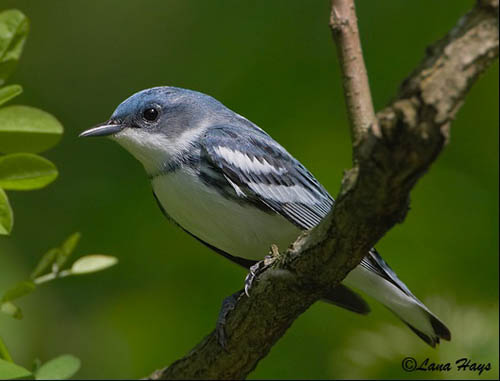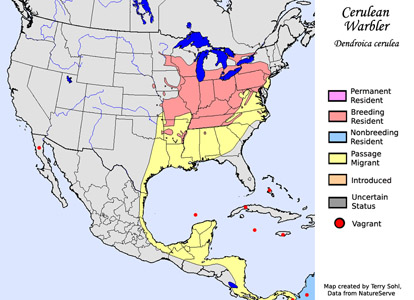| Length: 4.75 inches | Wingspan: 8 inches | Seasonality: Migrant |
|
ID Keys: (Male): Blue back, white throat and underparts, black
"necklace".
ID Keys (Female): Duller, slight bluish tinge on back, light eyebrow, crisp white wing-bars. |
||
 Cerulean Warblers are
becoming a less and less common sight in the eastern United States, as habitat
loss and fragmentation is thought to be behind a steady decline in recent
decades. They are also fairly common hosts to Cowbird
parasitism. They have been found fairly regularly in Newton Hills State Park,
but there are no regular records of breeding there (SDOU).
Cerulean Warblers are
becoming a less and less common sight in the eastern United States, as habitat
loss and fragmentation is thought to be behind a steady decline in recent
decades. They are also fairly common hosts to Cowbird
parasitism. They have been found fairly regularly in Newton Hills State Park,
but there are no regular records of breeding there (SDOU).
Habitat: Found in mature deciduous forests with a relatively open understory during the summer breeding season, especially along rivers and streams. Winters in similar forest habitats during the winter, often near forest edges and clearings.
Diet: Diet not well-known, but thought to feed almost exclusively on insects.
Behavior: Usually forages high in the trees, rapidly flitting from branch to branch in search of food items. Will also occasionally fly from perches to catch flying insects.
Breeding: Non-breeder in South Dakota
Song: A rapid buzzy song rising at the end. Click here to listen to the Cerulean Warbler's song.
Migration: Summers in scattered portions of the eastern United States and extreme southeastern Canada. Winters in South America.
Interactive eBird Map: Click for access to an interactive eBird map of Cerulean Warbler sightings
Similar Species: Black-throated Blue Warbler
South Dakota "Hotspot": A very rare visitor anywhere in the state, but Newton Hills State Park in Lincoln County is undoubtedly the best location to try and find these birds in South Dakota. They have been found there fairly regularly during the summer months and may be breeders there, although confirmed nesting records are few.
Conservation Status: Numbers are in decline in recent decades, most likely due to habitat loss and habitat fragmentation, both in its summer breeding grounds and on its wintering grounds.
Further Information: 1) Patuxent Bird Identification InfoCenter, Cerulean Warbler
3) Audubon Guide - Cerulean Warbler
Photo Information: Photo from Kentucky, courtesy of Lana Hays
| Click on the map below for a higher-resolution view |
 |
| South Dakota Status: Rare spring migrant in the eastern part of the state. Rare in summer in the extreme southeastern corner of the state. |
Additional Cerulean Warbler Photos (coming soon!)
